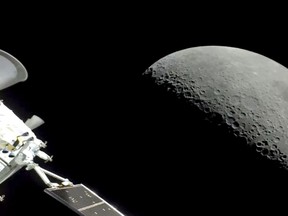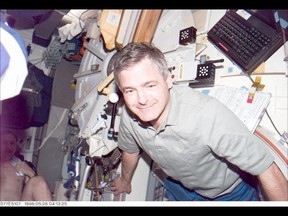
Article content
WASHINGTON — Ask Marc Garneau if he’d go back to space and the first Canadian to ever make the trip doesn’t hesitate: “In a wink.”
Advertisement 2
Article content
It’s another matter entirely, of course, whether the now-retired former astronaut and Quebec MP — at 74, he finally gave up his seat in the House of Commons just three weeks ago — still has the right stuff.
Article content
“You always wonder, when you reach a certain age, whether you would still have that capability that you had when you were younger,” said Garneau, who flew three Space Shuttle missions between 1984 and 2001.
“Having flown three times, I consider myself blessed beyond any reasonable expectation in life.”

Now the country’s pre-eminent “elder statesman” of space, Garneau has long waited for the day when he’ll be joined in the pantheon of pioneering explorers by the next astronaut to earn the “first Canadian” honorific.
Article content
Advertisement 3
Article content
Who will it be? The world finds out Monday.
That’s when NASA and the Canadian Space Agency will introduce the four astronauts — three from the U.S., one from Canada — who will steer the next stage of an ambitious plan to establish a long-term presence on the moon.
Scheduled to blast off as early as November 2024, Artemis II will be the first crewed mission to the moon since the final Apollo mission took flight in 1972. It will also be the first time a Canadian has ventured beyond Earth’s orbit.
Canada’s astronaut corps currently comprises four people, including David Saint-Jacques, an astrophysicist and medical doctor from Montreal and the only member of the group who’s already been to space.
Saint-Jacques, 53, flew to the International Space Station in 2018. He was selected for the corps in 2009 alongside Jeremy Hansen, 47, of London, Ont., a colonel and CF-18 pilot in the Royal Canadian Air Force.
Advertisement 4
Article content
Joining them in 2017 were test pilot and Air Force Lt.-Col. Joshua Kutryk, 41, from Fort Saskatchewan, Alta., and Jennifer Sidey, 34, a mechanical engineer and Cambridge University lecturer from Calgary.
“I’m not in any way jealous or envious,” Garneau said. “I’m just so excited that we are now taking Canada on what I would say is a major, major step forward.”
It’s not quite the giant leap of 1969, but it’s close — about 7,400 kilometres away, to be precise.
The four Artemis astronauts will encircle their home planet before sling-shotting into deep space for a figure-8 manoeuvre around the moon, making Canada and the U.S. the only two countries to ever pass over the dark side of the lunar surface.
“When I think back on 1984, when I first flew, we didn’t know what might happen after that,” Garneau said.
Advertisement 5
Article content
“To now have the opportunity for Canada to be only the second country to have an astronaut go on a lunar mission — this is extraordinary.”
It’s also the product of a tremendous amount of hard work and investment, said Western University professor Gordon Osinski, director of the school’s Institute for Earth and Space Exploration.
Osinski spent the bulk of last week in Houston, taking part in simulated spacewalks to better learn and understand how best to conduct the geological work future astronauts will be required to do on the lunar surface.
While that research isn’t directly related to Artemis, it’s bound to be a key factor down the road as the ultimate mission continues to evolve into something that will bear little resemblance to its Apollo ancestors.
Advertisement 6
Article content
“I can do field geology on Earth with a Star Trek-like instrument that tells me the chemistry of a rock. It wasn’t even imagined 50 years ago,” Osinski said.
“So as we progress in the whole Artemis program, I think you’ll really see 21st-century space exploration like we might imagine from Star Trek and things.”
Even now, Osinski is still incredulous that Canada managed to secure a spot on Artemis II — and he credits everything from the country’s geographical and economic ties with the U.S. to the ongoing work of the Canadian astronaut corps.
Then there’s the Canadarm, the articulated remote manipulators that became a fixture of Space Shuttle and International Space Station missions and a point of national pride for countless Canadians of a certain age.
Advertisement 7
Article content
“The U.S. has let go and said, ‘OK, Canada, we trust you enough that we’ll literally put the lives of our astronauts in your hand,”‘ Osinski said.
“So that trust maybe goes a long way to explain how we did it.”
The plan is to put a man and woman on the moon in 2025 in service of the ultimate goal: eventually dispatching astronauts to Mars. And Canada is expected to play a critical role going forward.
“We’re going back to the moon. The moon, that’s a big thing,” Innovation Minister Francois-Philippe Champagne said last week.
“This is Canada on the world stage, doing big things.”
That, ultimately, could be Artemis II’s biggest legacy for Canada: inspiring the next generation of astronauts in much the same way that Apollo did all those years ago.
This time, though, the visuals will be spectacular.
“As much as we get excited about robots and the Canadarm and things, having a personal experience in that could be a huge moment and a big milestone for the Canadian space program,” Osinski said.
“There’s just something about having an astronaut do that.”
This report by The Canadian Press was first published April 2, 2023.
https://news.google.com/rss/articles/CBMia2h0dHBzOi8vdG9yb250b3N1bi5jb20vbmV3cy9uYXRpb25hbC9nb2luZy1iYWNrLXRvLXRoZS1tb29uLWNhbmFkYXMtcm9sZS1pbi1hcnRlbWlzLWlpLWEtbWFqb3Itc3RlcC1mb3J3YXJk0gEA?oc=5
2023-04-02 15:11:58Z
CBMia2h0dHBzOi8vdG9yb250b3N1bi5jb20vbmV3cy9uYXRpb25hbC9nb2luZy1iYWNrLXRvLXRoZS1tb29uLWNhbmFkYXMtcm9sZS1pbi1hcnRlbWlzLWlpLWEtbWFqb3Itc3RlcC1mb3J3YXJk0gEA
Comments
Postmedia is committed to maintaining a lively but civil forum for discussion and encourage all readers to share their views on our articles. Comments may take up to an hour for moderation before appearing on the site. We ask you to keep your comments relevant and respectful. We have enabled email notifications—you will now receive an email if you receive a reply to your comment, there is an update to a comment thread you follow or if a user you follow comments. Visit our Community Guidelines for more information and details on how to adjust your email settings.
Join the Conversation